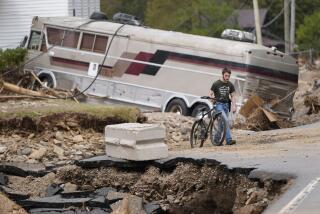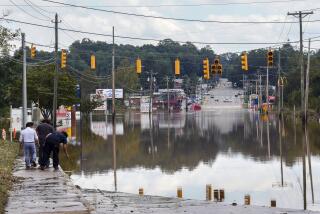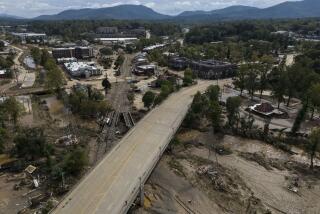Hurricane Veers Away From Carolinas : Storm: After approaching to about 60 miles from the coast, Dennis heads to sea. Rain and high winds leave thousands without power.
NAGS HEAD, N.C. — People along the North Carolina coast breathed sighs of relief Monday as Hurricane Dennis turned out to sea, sideswiping the shoreline with 112-mph gusts and a deluge that flooded streets and left tens of thousands without power.
The storm’s center started peeling away from the coast after getting no closer than 60 miles. The storm was blamed for two traffic deaths early Monday.
“We are hoping it continues that offshore track,” said Jim Jones, spokesman for the state Division of Emergency Management. “If it stalls far enough away, that’s fine, as long as it doesn’t come back.”
Storm damage was light. New Hanover’s losses totaled $217,000, whereas in Brunswick County, the collapse of a beachfront house at Ocean Isle Beach was the worst property damage reported, according to Cecil Logan of the county emergency management office.
“I’ve seen a bunch of bad weather in this area, but we’re real happy with how things turned out this time.” said Bob Sheppard, an employee at Harbor Inn in Wrightsville Beach.
“It was a dodged bullet,” said Susan Rogers, who spent Sunday night on Wrightsville Beach.
Still, forecasters warned that the danger wasn’t over. Jerry Jarrell of the National Hurricane Center in Miami said experts believe Dennis will stall at sea today and remain in the area for several days. What it will do after that is anyone’s guess.
“Unfortunately, one of our better models is showing that it comes back into the coast, not far from where it is right now, close to Norfolk [Virginia] or in that general vicinity,” he said.
Over the weekend Dennis moved on a plodding course parallel to the coasts of the Carolinas. Tens of thousands of residents and tourists were evacuated from the barrier islands, which are separated from the mainland by roads that get swamped in storms. The worst of the storm hit early Monday, churning up 30-foot seas.
Innkeeper Bob Touhey on Ocracoke Island, on North Carolina’s Outer Banks, said a friend’s wind gauge “got stuck at 74 mph before it blew off the house.”
Dennis was moving slowly in the ocean east of Cape Hatteras, N.C., with sustained winds of nearly 90 mph, from 105 mph in the morning. A tropical storm warning remained in effect for most of the North Carolina coast to the Virginia state line. Beaches as far north as New York’s Long Island were closed to swimmers.
As it crept northward, powerful winds and downpours lashed the Wilmington area and other beaches on the southeastern coast of North Carolina.
For a time, it seemed yet another hurricane might cross Cape Fear, directly south of Wilmington, as Bertha and Fran did in 1996 and Bonnie did in 1998. Bertha killed 25 people and caused about $6 billion in damage.
Shortly before noon, as Dennis approached the Outer Banks--which stick out from the Atlantic Seaboard like the side-view mirror on a car--it began edging away from the coast.
Two people were killed in a head-on collision in the lowland community of Richlands as 60-mph gusts and 2 inches of rain blasted the area. In St. Augustine Beach, Fla., a 45-year-old surfer apparently drowned in heavy waves, officials said. The man’s body was found early Saturday.
The storm knocked out power to more than 50,000 people as far inland as the Raleigh area. In southeast Virginia, 22,500 customers were without electricity.
More to Read
Sign up for Essential California
The most important California stories and recommendations in your inbox every morning.
You may occasionally receive promotional content from the Los Angeles Times.










